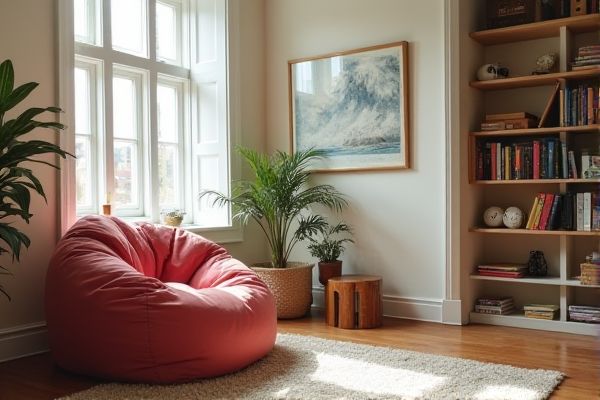
A bean bag offers casual, flexible seating that molds to your body for comfort, while a reading chair provides structured support and often comes with features like armrests and back support ideal for prolonged reading sessions. Discover which option best suits your reading habits and space by exploring the full comparison in this article.
Table of Comparison
| Feature | Bean Bag | Reading Chair |
|---|---|---|
| Comfort | Soft, conforms to body shape | Ergonomic support, firm cushion |
| Support | Minimal lumbar support | Strong back and arm support |
| Durability | Medium, depends on fabric quality | High, solid frame and materials |
| Portability | Lightweight, easy to move | Heavier, less portable |
| Space | Flexible, easily stored | Fixed size, needs dedicated space |
| Cost | Affordable to mid-range | Mid-range to expensive |
| Best Use | Casual lounging, informal seating | Focused reading, long sessions |
Introduction to Bean Bags and Reading Chairs
Bean bags offer a flexible and casual seating option, shaped to contour comfortably around the body, making them ideal for relaxed environments and informal reading sessions. Reading chairs provide structured support, often featuring ergonomic designs and cushioning tailored to enhance posture during extended reading periods. Both choices cater to distinct comfort preferences, with bean bags promoting a laid-back ambiance and reading chairs emphasizing stability and back support.
Comfort Comparison: Bean Bag vs Reading Chair
Bean bags offer a flexible, moldable surface that adapts to your body shape, providing casual comfort perfect for lounging. Reading chairs typically provide structured support with ergonomic features like armrests and backrests, enhancing posture during extended reading sessions. Your choice depends on whether you prioritize relaxed, informal seating or a supportive, upright position for comfort.
Ergonomic Benefits: Support and Posture
Bean bags mold to the body's contours, offering customizable comfort but limited structured support, which may lead to poor posture over extended reading sessions. Reading chairs are designed with ergonomic features such as lumbar support and adjustable positions, promoting better spinal alignment and reducing strain. For sustained reading, reading chairs provide superior support and help maintain healthier posture compared to bean bags.
Style and Aesthetic Appeal
Bean bags offer a casual, modern style with vibrant colors and flexible shapes that complement contemporary and playful interiors. Reading chairs provide a more classic and sophisticated aesthetic, often featuring structured designs, upholstery, and wooden accents that enhance traditional or cozy reading nooks. Choosing between them depends on the desired ambiance, with bean bags emphasizing comfort and informality, while reading chairs prioritize elegance and structured support.
Space and Portability Considerations
Bean bags offer exceptional portability and can be easily moved or stored, making them ideal for small spaces and flexible seating arrangements. Reading chairs tend to be bulkier and more structured, requiring dedicated space but providing better back support and a more defined reading posture. Depending on your room size and need for mobility, choosing between a lightweight bean bag or a sturdy reading chair can optimize both comfort and spatial efficiency.
Durability and Maintenance
Bean bags made with high-quality, tear-resistant fabric and dense foam filling offer moderate durability but may flatten over time, requiring occasional fluffing or replacement of beads. Reading chairs constructed from solid wood or metal frames with upholstered cushions typically provide longer-lasting support and easier maintenance through removable, washable covers. Choosing materials like leather or microfiber for reading chairs enhances durability, resisting stains and wear for low-maintenance care.
Cost Analysis: Affordability and Value
Bean bags typically offer a more affordable seating option with price ranges between $30 to $150, making them ideal for budget-conscious buyers seeking casual comfort. Reading chairs, often priced from $150 to over $500, provide enhanced support and durability, delivering greater long-term value for frequent readers. Considering factors like material quality, ergonomic design, and intended use, reading chairs generally offer superior investment value despite a higher initial cost.
Best Uses: Activities and Environments
Bean bags excel in casual environments like living rooms and play areas, offering flexible seating ideal for lounging, gaming, or relaxed reading sessions. Reading chairs provide structured support perfect for focused activities such as extended reading or studying, fitting well in home offices, libraries, or quiet nooks. Choosing between them depends on Your preferred activity duration and desired posture support.
Pros and Cons of Bean Bags
Bean bags offer unmatched comfort and flexibility, conforming to the body for relaxed lounging, but they often lack proper back support for extended reading sessions. Their lightweight design makes them easily portable and suitable for casual areas, yet they can appear informal and may not complement more traditional or structured decor. Cleaning can be challenging due to fabric types, and durability varies, with some bean bags losing shape over time.
Pros and Cons of Reading Chairs
Reading chairs offer superior ergonomic support, promoting proper posture and reducing strain during extended reading sessions. Their structured design often includes features like adjustable backs and armrests, enhancing comfort but potentially limiting flexibility in small spaces. You may find that while reading chairs provide better support than bean bags, they can be less portable and more expensive.
 homyna.com
homyna.com